Do you follow a proper plan or strategy for IBPS RRB Mains 2019? Are you aiming IBPS RRB 2019 this time? If yes, then this is the section which can help you to do wonders if practiced well. A good attempt with a mix of accuracy can help you fetch good marks. The reasoning is a game of wits and mind. It is all about logics that a question may have. Speed and accuracy are what that matters the most in this section. The only way to achieve an ambitious goal is by practicing only. So, attempt the quiz of Reasoning ability that inculcates the important questions from the important topics. Do not miss out to practice the Reasoning Ability Quiz that is being provided on Bankersadda.
Directions (1-5): Each of the questions below, consist a question and three statements numbered I, II and III. You have to decide whether the data provided in the statements are sufficient to answer the question. Read the three statements and Give answer.
Q1. There are seven persons i.e. A, B, C, M, K, T and L in a family. Find that K is paternal uncle of T?
I. M is brother of K and is married to L, who is mother of A. A is sister of T.
II. B is brother of A. C is the only son of K.
III. B is the only son of K, who is the brother-in-law of L. C is sister of B
(a) If the data in statement I and II together are sufficient to answer the question, while the data in statement III are not required to answer the question.
(b) If the data in statement I and III together are sufficient to answer the question, while the data in statement II are not required to answer the question.
(c) If the data in statement II and III are sufficient to answer the question, while the data in statement I are not required to answer the question.
(d) If the data in all three statements I, II and III together are necessary to answer the question.
(e) If the data in all the statements, I, II and III even together are not sufficient to answer the question.
S1. Ans.(b)
Sol. Using statement I and III, we get our final relation.
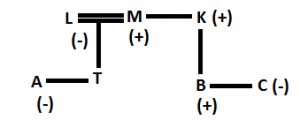
Q2. Who among M, N, P, Q, R and S is the heaviest?
I. P is heavier than only two of them. S is heavier than R and Q.
II. R is lighter than both Q and N but N is heavier than P but lighter than both S and M.
III. S is lighter than M.
(a) If the data in statement I and II together are sufficient to answer the question, while the data in statement III are not required to answer the question.
(b) If the data in statement I and III together are sufficient to answer the question, while the data in statement II are not required to answer the question.
(c) If the data in statement II and III are sufficient to answer the question, while the data in statement I are not required to answer the question.
(d) If the data in all three statements I, II and III together are necessary to answer the question.
(e) If the data in all the statements, I, II and III even together are not sufficient to answer the question.
S2. Ans.(d)
Sol. From statement I, II, III we get the following arrangement. M is the heaviest.
![]()
Q3. There are six persons A, B, C, D, E and F sitting in a row facing north. Who among the following sits 2nd to the right of C?
I. C sits 2nd to right of the one who sits at the left end of the row. A does not sit any of the extreme end.
II. A sits on the immediate left of B, who sits 4th to the right of C.
III. D sits 2nd to the left of E. D sits at one of the ends.
(a) If the data in statement I and II together are sufficient to answer the question, while the data in statement III are not required to answer the question.
(b) If the data in statement I and III together are sufficient to answer the question, while the data in statement II are not required to answer the question.
(c) If the data in statement II and III are sufficient to answer the question, while the data in statement I are not required to answer the question.
(d) If the data in all three statements I, II and III together are necessary to answer the question.
(e) If the data in all the statements, I, II and III even together are not sufficient to answer the question.
S3. Ans.(c)
Sol. From II and III we get the final sitting arrangement in which F sits 2nd to the right of C.

Q4. How many sons does M have?
I. N is brother G. A is sister of N. K is mother of B.
II. G is the brother B, who is the son K.
III. M is married to K.
(a) If the data in statement I and II together are sufficient to answer the question, while the data in statement III are not required to answer the question.
(b) If the data in statement I and III together are sufficient to answer the question, while the data in statement II are not required to answer the question.
(c) If the data in statement II and III are sufficient to answer the question, while the data in statement I are not required to answer the question.
(d) If the data in all three statements I, II and III together are necessary to answer the question.
(e) If the data in all the statements, I, II and III even together are not sufficient to answer the question.
S4. Ans.(c)
Sol.
From statement II, and III, we get our final answer. M has two sons.

Q5. What does the code ‘lz’ stands for in the given coded language?
I. In a language, ‘Sun water roof’ is coded as ‘am nl or’ and ‘food room plate’ is coded as ‘st od wa’
II. In a language, ‘stem plant leave’ is coded as ‘er az op’ and ‘food plate water’ is coded as ‘od st nl’
III. In the language, ‘flower air Sun’ is coded as ‘pa am lz’ and ‘food plant leave’ is coded as ‘az od er’
(a) If the data in statement I and II together are sufficient to answer the question, while the data in statement III are not required to answer the question.
(b) If the data in statement I and III together are sufficient to answer the question, while the data in statement II are not required to answer the question.
(c) If the data in statement II and III are sufficient to answer the question, while the data in statement I are not required to answer the question.
(d) If the data in all three statements I, II and III together are necessary to answer the question.
(e) If the data in all the statements, I, II and III even together are not sufficient to answer the question.
S5. Ans.(e)
Sol. All the three statements are not sufficient to answer the question.
Direction (6-10): Study the following information carefully and answer the question given below-
Top ten students viz. A, B, C, D, E, F, G, H, I and J of a school are sitting in a row facing north for price distribution ceremony. All of them got ranks as 1st, 2nd, 3rd and so on up to 10th as per their performance in exam but not necessarily in the same order. J sits an extreme right end and does not get 2nd and 4th rank. C sits third to the left of G who sits third to the left of D. The immediate neighbour of D got 2nd rank. B sits second to the right of A, who got the 5th rank. Both C and F are immediate neighbour of each other but none of them sits at an extreme end. The one who got 1st rank sits between the one who got 5th and 7th rank. B is not an immediate neighbour of D. E sits fourth to the right of F.H got 3rd rank and is not an immediate neighbour of C. The one who got 8th rank sits at an extreme left end. F neither got 1st nor 6th rank. The one who got 9th rank sits second to the right of the one who got 6th rank. C got the last rank.
Q6. Who amongst the following sit at extreme ends of the row?
(a) C, F
(b) D, I
(c) A, G
(d) I, J
(e) None of these
Q7. How many persons are seated between F and D?
(a) One
(b) Two
(c) Three
(d) Four
(e) None
Q8. Which of the following is true regarding B?
(a) B sits second to right of C.
(b) B is not an immediate neighbour of E.
(c) B sits third to right of A
(d) B sits at one of the extreme ends of the line.
(e) B’s rank is 7th.
Q9.C is related to A in the same way as D is related to J. Which of the following is G related to, following the same pattern?
(a) D
(b) E
(c) I
(d) F
(e) None of these
Q10. What is rank of J?
(a) 3rd
(b) 4th
(c) 6th
(d) 7th
(e) 9th
Solutions (6-10):

S6. Ans.(d)
S7.Ans.(d)
S8.Ans.(e)
S9.Ans.(b)
S10.Ans.(e)
Direction (11-12): Study the following information carefully and answer the given questions:
Ram is standing at a distance of 5 m east to Shyam. Both of them started walking 5m in north direction, then Ram takes three consecutive left turns and walked distances 5m,3m,2m respectively and Shyam takes three consecutive right turns and walked distances 5m,3m,2m respectively.
Q11. In which direction and at what distance is Ram’s final point with respect to Shyam’s final point?
(a) west, 2m
(b) east, 1m
(c) west,1m
(d) east, 5m
(e) none of these
Q12. What is the shortest distance and in which direction Ram’s final point with respect to Shyam’s Initial point?
(a) north west, 3m
(b) north east, 22m
(c) south west, 22m
(d) north west, 22m
(e) none of these
Solutions (11-12):
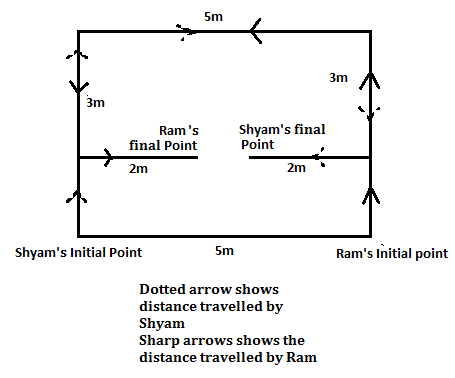
S11.Ans(c)
S12. Ans(b)
Directions (13-14): Study the following information carefully and answer the question given below:
A person starts walking towards north direction. After walking 5km he reached at point X. From there he takes a right turn and walk 3km, then again he took a right turn and walked 2km and reached point Y. From there he took a left turn and walk 2km. Thereafter he takes a left turn and walk 3km and reached point Z.
Q13. Then find out the shortest distance and direction of point Z from his first turning point?
(a) √23km, north east
(b) √11km, south west
(c) √21km, north-west
(d) √26km, north-east
(e) none of these
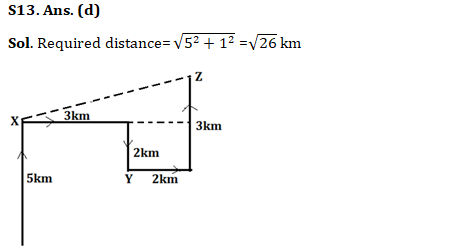
Q14. If a point Q is 5km to east of point Y then find out the direction of Q with respect to X?
(a) north-east
(b) south-east
(c) north-west
(d) south
(e) none of these
S14. Ans. (b)
Sol.
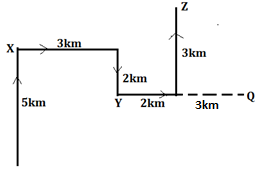
Q15. Statement: There is little that is surprising about India’s recent refusal to allow Google to launch its street view service, which gives users a 360-degree view of public spaces. The proposal was rejected following objections raised by the Defense Minister.
Which of the following objection(s) may not be a probable reason(s) for the above step taken by the government?
(a) The decision is said to have come in the backdrop of the terror attack on the Pathankot airbase, with investigators suspecting that terrorists used Google maps to study the topography of the targeted area.
(b) The concerns of the defense organizations should be taken into consideration.
(c) India’s security and stability should be given prime importance.
(d) We Indians are not mature enough to permit such exploratory things threatening national security. We have more enemies inside than outside.
(e) All of the above.
S15. Ans.(d)
Sol. All the options may be the probable reasons except option (d) because the reason in that option is contradictory to the statement. We Indians are matured enough to permit such exploratory things threatening national security. So, this must not be a probable reason.
If you are preparing for Bank exams, then you can also check out a video for Reasoning below:
You may also like to Read:

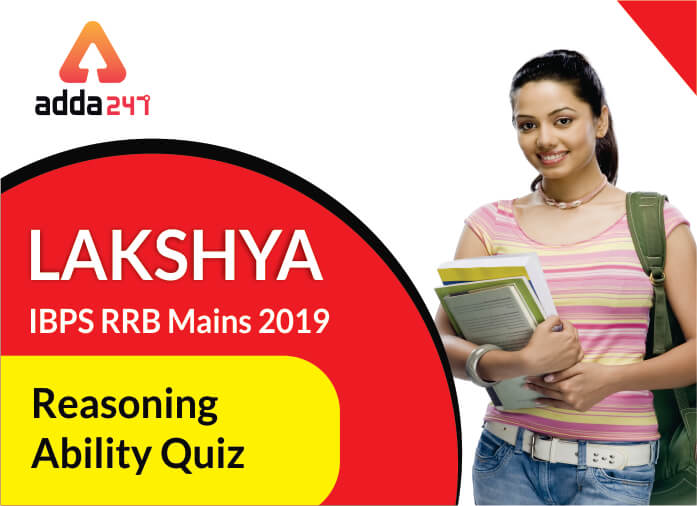
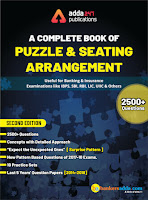


 GA Capsule for SBI Clerk Mains 2025, Dow...
GA Capsule for SBI Clerk Mains 2025, Dow...
 The Hindu Review October 2022: Download ...
The Hindu Review October 2022: Download ...
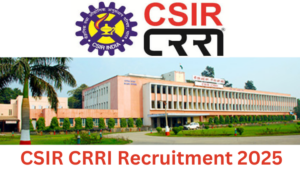 Delhi CSIR CRRI Recruitment 2025 Notific...
Delhi CSIR CRRI Recruitment 2025 Notific...







